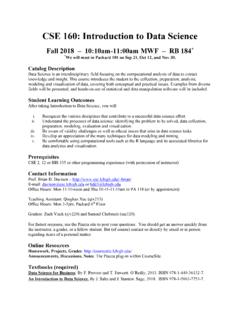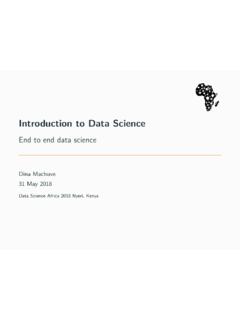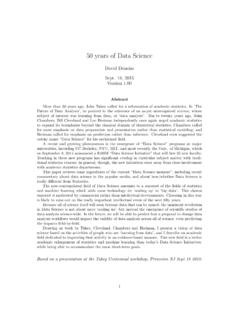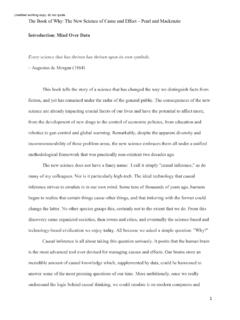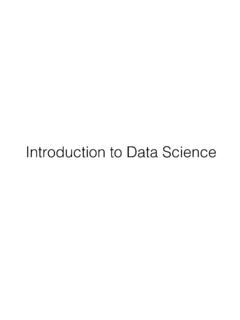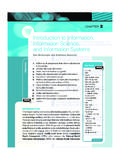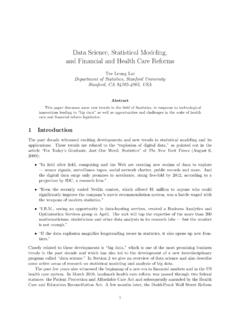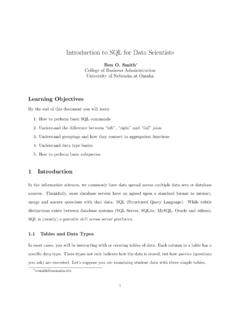Transcription of Cloudera Introduction to Data Science: Building ...
1 TRAINING SHEETC loudera Introduction to data Science: Building recommender Systems Take Your Knowledge to the Next Level with Cloudera s data Science Training and CertificationData scientists build information platforms to ask and answer previously unimaginable questions. Learn how data science helps companies reduce costs, increase profits, improve products, retain customers, and identify new opportunities. Cloudera University s three-day course helps participants understand what data scientists do and the problems they solve. Through in-class simulations, participants apply data science methods to real-world challenges in different industries and, ultimately, prepare for data scientist roles in the Hadoop Through instructor-led discussion and interactive, hands-on exercises, participants will navigate the Hadoop ecosystem, learning topics such as.
2 The role of data scientists, vertical use cases, and business applications of data science Where and how to acquire data , methods for evaluating source data , and data transformation and preparation Types of statistics and analytical methods and their relationship Machine learning fundamentals and breakthroughs, the importance of algorithms, and data as a platform How to implement and manage recommenders using Apache Mahout and how to set up and evaluate data experiments Steps for deploying new analytics projects to production and tips for working at scaleAudience & Prerequisites This course is suitable for developers, data analysts, and statisticians with basic knowledge of Apache Hadoop: HDFS, MapReduce, Hadoop Streaming, and Apache Hive.
3 Students should have proficiency in a scripting language; Python is strongly preferred, but familiarity with Perl or Ruby is sufficient. data Scientist CertificationUpon completion of the course, attendees are encouraged to continue their study and register for the Cloudera Certified Professional: data Scientist (CCP:DS) exam. Certification is a great differentiator; it helps establish you as a leader in the field, providing employers and customers with tangible evidence of your skills and expertise. The professionalism and expansive technical knowledge demonstrated by our instructor were incredible. The quality of the Cloudera training was on par with a university. General Dynamics 2015 Cloudera , Inc. All rights reserved.
4 Cloudera and the Cloudera logo are trademarks or registered trademarks of Cloudera Inc. in the USA and other countries. All other trademarks are the property of their respective companies. Information is subject to change without notice. Cloudera -training-sheet- Introduction -to- data -science-1031-888-789-1488 or 1-650-362-0488 Cloudera , Inc., 1001 Page Mill Road, Palo Alto, CA 94304, USA SHEETI ntroductionData Science Overview What Is data Science? The Growing Need for data Science The Role of a data ScientistUse Cases Finance Retail Advertising Defense and Intelligence Telecommunications and Utilities Healthcare and PharmaceuticalsProject Lifecycle Steps in the Project Lifecycle Lab Scenario ExplanationData Acquisition Where to Source data Acquisition TechniquesEvaluating Input data data Formats data Quantity data QualityData Transformation Anonymization File Format Conversion Joining DatasetsData Analysis and Statistical Methods Relationship Between Statistics and Probability Descriptive Statistics Inferential StatisticsFundamentals of Machine Learning Overview The Three Cs of Machine Learning Spotlight.
5 Na ve Bayes Classifiers Importance of data and AlgorithmsRecommender Overview What Is a recommender system ? Types of Collaborative Filtering Limitations of recommender Systems Fundamental ConceptsIntroduction to Apache Mahout What Apache Mahout Is (and Is Not) A Brief History of Mahout Availability and Installation Demonstration: Using Mahout s Item-Based RecommenderCourse Outline: Cloudera Introduction to data ScienceImplementing Recommenders with Apache Mahout Overview Similarity Metrics for Binary Preferences Similarity Metrics for Numeric Preferences ScoringExperimentation and Evaluation Measuring recommender Effectiveness Designing Effective Experiments Conducting an Effective Experiment User Interfaces for RecommendersProduction Deployment and Beyond Deploying to Production Tips and Techniques for Working at Scale Summarizing and Visualizing Results Considerations for Improvement Next Steps for RecommendersConclusion Appendix A : Hadoop OverviewAppendix B: Mathematical FormulasAppendix C : Language and Tool Referenc
